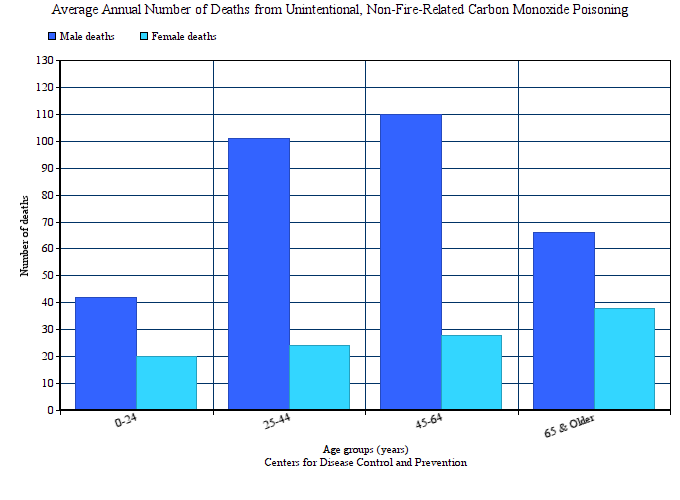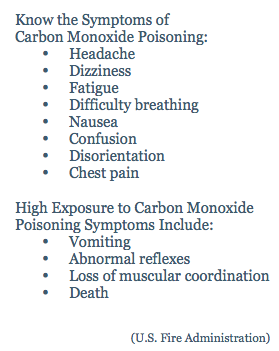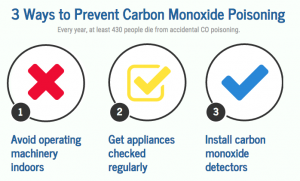
A $300 gas bill raised suspicion in four roommates — something wasn’t right. They then discovered the carbon monoxide level in their home to be nearly 95 times higher than what is considered safe.
Professionals detected a natural gas leak in the house along with highly unsafe levels of carbon monoxide, which was the result of a faulty furnace and water heater. An acceptable average level of carbon monoxide exposure in the home is 30 parts per million and below, according to the United States Environmental Protection Agency.
Haeree Kim, along with her three roommates, lived in the neighborhood of Capitol Hill in Salt Lake City in 2014. They realized they had been exposed to carbon monoxide from the time they turned their heater on in November 2014 until the hazard was discovered in January 2015.
Carbon monoxide, commonly referred to as the “silent killer,” is produced by the partial burning of carbon-containing fuels like gas, oil and coal. Gas can build up in any place that is poorly ventilated where a natural gas range, water heater, furnace, fireplace or running engine is present.
Exposure to this odorless, tasteless and colorless poison commonly causes symptoms such as headache, nausea, vomiting, dizziness, fatigue and confusion. Oftentimes, victims become unconscious and could die because the poison cannot be detected by human senses.
“Unfortunately, people die every year from carbon monoxide poisoning, and they can’t be treated,” said Lindell K. Weaver, who specializes in hyperbaric and undersea medicine and works at the LDS Hospital Hyperbaric Medicine department in Salt Lake City.

A total of 5,149 people died from accidental carbon monoxide poisoning in the U.S. from 1999-2010 — an average of 430 annual deaths, according to the most recent mortality rates from the Centers for Disease Control and Prevention.
Although Kim is grateful she survived the poisoning, the prolonged exposure has left her with debilitating health problems she never expected.
“I didn’t even know what being poisoned meant,” Kim said. “I would have never known what that would mean for me.”
Carbon monoxide exposure leads to inflammation in the brain and other tissues because of a lack of oxygen in the body. The prolonged exposure Kim experienced has caused restricted breathing, increased fatigue, headaches, depression, anxiety and memory loss — symptoms she didn’t have before the incident.
Prior to the carbon monoxide poisoning, Kim felt good about her job as a research assistant at the University of Utah.
“But throughout the winter, I became increasingly overwhelmed with thoughts of quitting. I had to force myself to get up to go to school and work,” Kim said.
Weaver said he typically advises hyperbaric oxygen therapy to victims of carbon monoxide poisoning because it reduces the risk of lasting brain damage the poison can cause.
The treatment requires patients to go inside an enclosed chamber where they breathe pure oxygen at increased pressure. This treatment is beneficial in several ways as it simultaneously flushes out the carbon monoxide from the body while flooding it with the oxygen it has been deprived of. It also blocks the inflammatory effects of the poison.
“There is no other agent or drug that can accomplish all of these things,” Weaver said.
Weaver said he believes the treatment produces the best results when administered up to six hours after the poisoning incident, but Kim wasn’t referred to Weaver until several weeks after she found out about the exposure.
“There’s no specific treatment at that point,” Weaver said. “They have brain injury.”
In these cases, Weaver said he refers patients to neurologists and other specialists who can hopefully help, although some patients will never fully recover.

It’s been two years since Kim was poisoned by carbon monoxide. While she said the physical symptoms have improved, she’s still recovering emotionally.
“I am a different person than I was before,” Kim said. “My capabilities have dwindled. I have anxiety a lot. I have suicidal ideation and battle feelings of incompetence.”
Kim said she was aware of carbon monoxide poisoning before her experience but unaware of the different ways it can cause harm. A person can be poisoned by carbon monoxide in large amounts over a short period of time or in smaller amounts over a long period of time.
Weaver said it’s important to take the right precautions in order to avoid these carbon monoxide poisoning tragedies.
“Treatment is all well and good, but prevention is best,” Weaver said. “If there’s prevention, then there’s nobody to treat.”

Weaver suggests avoiding operating machinery indoors, never allowing a car engine to run inside, getting furnaces and gas ranges checked annually and installing carbon monoxide detectors.
Paul Barton, BYU assistant director of residence life, said detectors need to be installed wherever there is a natural gas range.
Barton advised students in both on- and off-campus housing to check safety items on the housing guidelines and be proactive about them.
Kim said she hopes others will educate themselves on carbon monoxide poisoning and take the necessary precautions to protect themselves from it. As for her journey, she’s still seeking peace.
“This changed my life dramatically,” Kim said. “I feel really sad about the experience. I am scared and especially overwhelmed that it is still going on.”




